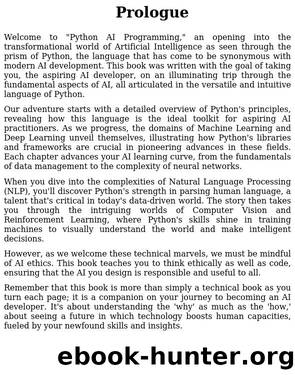Python AI Programming by Patrick J

Author:Patrick J
Language: eng
Format: epub, pdf
Publisher: GitforGits
Overfitting and Underfitting
Understanding Overfitting
What is Overfitting?
Overfitting is a critical issue in machine learning in which the model learns excessively from the training data, to the point of absorbing its noise and outliers. This is analogous to memorizing a book without understanding the underlying story; the model becomes overly complex, latching onto deceptive patterns in the training data that do not apply to new, unseen data.
Signs of Overfitting
Overfitting symptoms are frequently obvious. For example, the model may be extremely accurate on training data but perform poorly on new or test data. The model has learned the noise and random fluctuations in the training data, mistaking them for meaningful trends rather than understanding the actual underlying patterns.
Preventing Overfitting
Several strategies can be used to avoid overfitting. One method is to simplify the model, either by reducing the number of features it employs or by reducing its overall complexity. Cross-validation is another effective method that involves dividing the training data into several subsets. After that, the model is trained and validated on these various subsets, allowing it to learn more generalized patterns. Regularization techniques such as Lasso or Ridge regression can also be used to keep the model from becoming too complex by penalizing overfitting. Finally, increasing the volume of training data can help because it gives the model a wider range of examples to learn from, reducing the model's tendency to overfit to a limited set of data.
Understanding Underfitting
What is Underfitting?
Underfitting in machine learning is the opposite extreme of model inaccuracy, in which the model is overly simplistic and unable to discern the important patterns in the data. This is analogous to attempting to understand the nuances of a complex story based solely on a brief summary. In these cases, the model's simplicity impedes its learning process, resulting in poor performance not only on unseen data but also on training data.
Signs of Underfitting
The signs of underfitting are simple to identify. The model performs noticeably poorly even on training data, indicating the model's inability to capture the data's complexity and variability. This is frequently due to the model's overly simplistic structure, which lacks the ability to understand or represent the data's intricate relationships.
Preventing Underfitting
Several measures can be implemented to combat underfitting. Increasing the model's complexity is one effective strategy. This can be accomplished by adding more features to the model or by employing more sophisticated and capable modeling techniques. Furthermore, ensuring that the model receives adequate training is critical, as under-trained models frequently underfit. Another critical strategy is feature engineering, which entails improving the quality and relevance of input data. The model receives more informative and nuanced information as the input data is refined, which can aid in capturing the true underlying patterns in the data.
Significance of Overfitting and Underfitting
Both overfitting and underfitting are detrimental to the performance of a model. They impair a model's ability to generalize, which is required for making accurate predictions on new, previously unseen data. To avoid these issues and create a model that not only learns well from
Download
This site does not store any files on its server. We only index and link to content provided by other sites. Please contact the content providers to delete copyright contents if any and email us, we'll remove relevant links or contents immediately.
The Mikado Method by Ola Ellnestam Daniel Brolund(20293)
Hello! Python by Anthony Briggs(19621)
Secrets of the JavaScript Ninja by John Resig Bear Bibeault(17890)
Dependency Injection in .NET by Mark Seemann(17855)
The Well-Grounded Java Developer by Benjamin J. Evans Martijn Verburg(17298)
OCA Java SE 8 Programmer I Certification Guide by Mala Gupta(17208)
Adobe Camera Raw For Digital Photographers Only by Rob Sheppard(16928)
Kotlin in Action by Dmitry Jemerov(16849)
Algorithms of the Intelligent Web by Haralambos Marmanis;Dmitry Babenko(15991)
Grails in Action by Glen Smith Peter Ledbrook(15158)
Sass and Compass in Action by Wynn Netherland Nathan Weizenbaum Chris Eppstein Brandon Mathis(13111)
Secrets of the JavaScript Ninja by John Resig & Bear Bibeault(11266)
A Developer's Guide to Building Resilient Cloud Applications with Azure by Hamida Rebai Trabelsi(10575)
Test-Driven iOS Development with Swift 4 by Dominik Hauser(10312)
Jquery UI in Action : Master the concepts Of Jquery UI: A Step By Step Approach by ANMOL GOYAL(9279)
Hit Refresh by Satya Nadella(9071)
The Kubernetes Operator Framework Book by Michael Dame(8520)
Exploring Deepfakes by Bryan Lyon and Matt Tora(8343)
Robo-Advisor with Python by Aki Ranin(8288)
